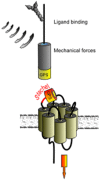Adhesion G Protein-Coupled Receptors: From In Vitro Pharmacology to In Vivo Mechanisms
- PMID: 25956432
- PMCID: PMC4551055
- DOI: 10.1124/mol.115.098749
Adhesion G Protein-Coupled Receptors: From In Vitro Pharmacology to In Vivo Mechanisms
Abstract
The adhesion family of G protein-coupled receptors (aGPCRs) comprises 33 members in humans. aGPCRs are characterized by their enormous size and complex modular structures. While the physiologic importance of many aGPCRs has been clearly demonstrated in recent years, the underlying molecular functions have only recently begun to be elucidated. In this minireview, we present an overview of our current knowledge on aGPCR activation and signal transduction with a focus on the latest findings regarding the interplay between ligand binding, mechanical force, and the tethered agonistic Stachel sequence, as well as implications on translational approaches that may derive from understanding aGPCR pharmacology.
Copyright © 2015 by The American Society for Pharmacology and Experimental Therapeutics.
Figures



References
-
- Adams MN, Ramachandran R, Yau MK, Suen JY, Fairlie DP, Hollenberg MD, Hooper JD. (2011) Structure, function and pathophysiology of protease activated receptors. Pharmacol Ther 130:248–282. - PubMed
-
- Aust G. (2010) Adhesion-GPCRS in tumorigenesis. Adv Exp Med Biol 706:109–120. - PubMed
-
- Aust G, Eichler W, Laue S, Lehmann I, Heldin NE, Lotz O, Scherbaum WA, Dralle H, Hoang-Vu C. (1997) CD97: a dedifferentiation marker in human thyroid carcinomas. Cancer Res 57:1798–1806. - PubMed
Publication types
MeSH terms
Substances
Grants and funding
LinkOut - more resources
Full Text Sources
Other Literature Sources
Molecular Biology Databases

